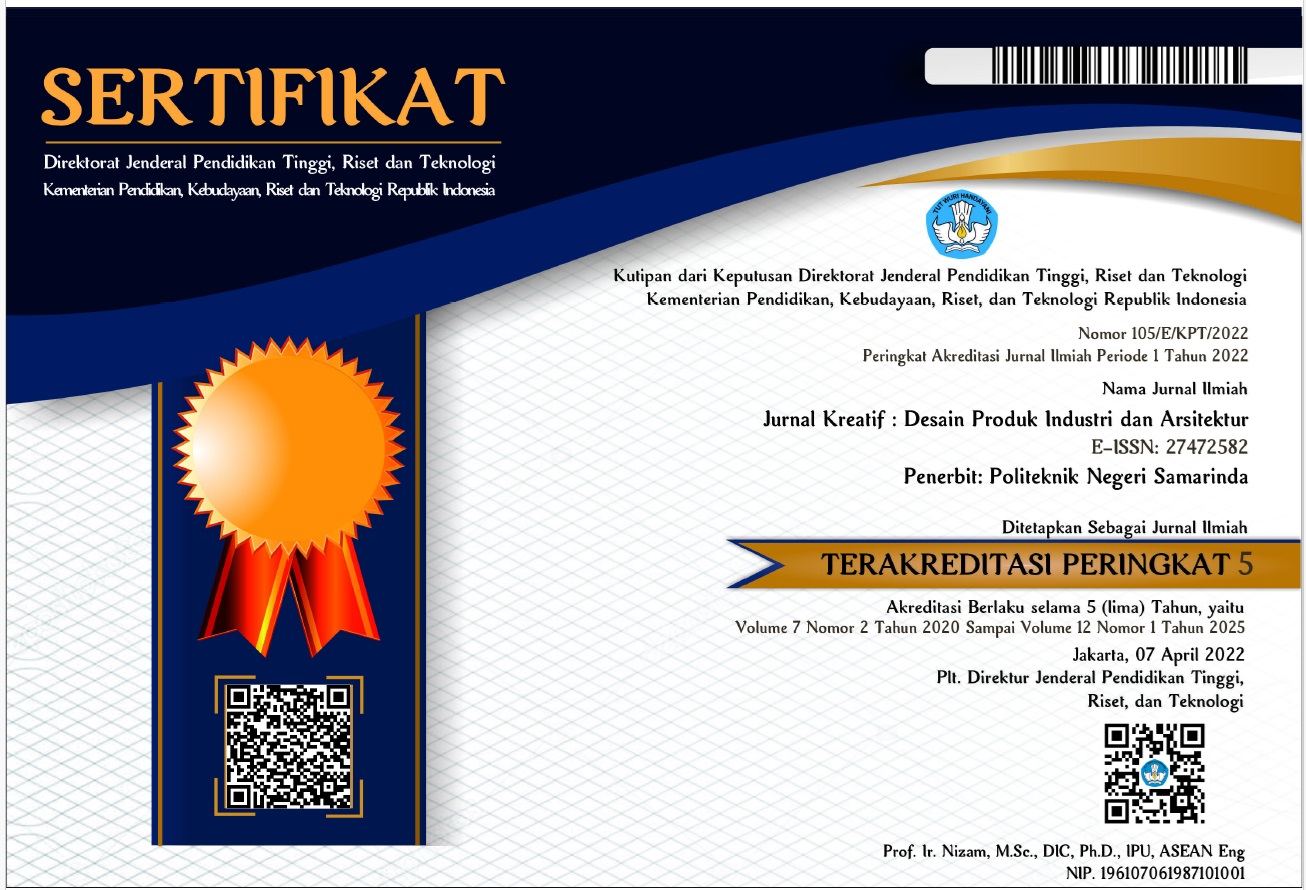KONSEP DESAIN TAS MODULAR FOTOGRAFI DAN VIDEOGRAFI
 Abstract views: 2531
,
Abstract views: 2531
,
 pdf downloads: 1826
pdf downloads: 1826
Abstract
Abstrak
Fotografi dan Videografi merupakan kegiatan atau profesi yang berhubungan dengan makhluk hidup. Dapat dilakukan oleh semua orang dan dapat dijadikan sebagai hobi maupun sebagai profesi. Dari kegiatan tersebut terdapat sebuah benda yang menjadi faktor utama selain kamera maupun drone, yaitu tas. Tas menjadi faktor utama sebagai tempat penyimpanan peralatan kamera pada saat para fotografer dan videografer melakukan kegiatan.
Untuk saat ini perkembangan tas sangat bervariasi mulai dari bentuk yang kecil hingga bentuk yang besar. Terdapat berbagai jenis tas kamera, yaitu tas ransel, tas selempang, hingga tas jenis koper. Untuk masalah penempatan masih banyak yang bisa dikembangkan dari segi peletakkan peralatan hingga sistem pada tas. Penelitian ini dilakukan melalui dua proses, yaitu data literartur dan data lapangan. Data literatur didapatkan melalui sumber dari internet ataupun buku yang berkaitan dengan dengan penelitian. Sedangkan untuk data lapangan didapatkan melalui hasil survey, wawancara, dan observasi dengan para fotografer dan videografer. Proses perancangan memiliki beberapa tahapan antara lain, tahap pengumpulan data, tahap analisis, dan kebutuhan desain. Tahap analisis menggunakan analisis kebutuhan desain yang meliputi peralatan yang dibutuhkan fotografer dan videografer. Dilanjutkan dengan analisis warna, analisis material, analisis bentuk, analisis ergonomi, analisis sistem, analisis kompetitor, dan analisis tambahan. Disimpulkan antara lain, penelitian ini dengan hasil akhir produk tas ransel (backpack) desain tas modular fotografi dan videografi ialah agar memudahkan para fotografer dan videografer pada saat membawa peralatan, dan termasuk sebagai inovasi terbaru..
Kata kunci : Tas ransel, Modular, Fotografi, Videografi
Abstract
Photography and Videography are activities or professions related to living things. It can be done by everyone and can be used as a hobby or as a profession. From these activities there is an object becomes the main factor besides the camera or drone, namely the bag. Bags become the main factor as a place to store camera equipment when photographers and videographers do any activities. Nowadays the development of bags varies greatly from small to large shapes. There are various types of camera bags, namely backpacks, sling bags, to suitcase type bags. For the problem of placement, there is still much that can be developed in terms of laying equipment to the system in the bag. This research was conducted through two processes, namely literary data and field data. Literature data are obtained through sources from the internet or books related to research. As for the field data, were obtained through the results of surveys, interviews, and observations with photographers and videographers. The design process has several stages including, the data collection stage, the analysis phase, and the design requirements. The analysis phase uses an analysis of design requirements which includes equipment needed by photographers and videographers. Followed by color analysis, material analysis, shape analysis, ergonomics analysis, system analysis, competitor analysis, and additional analysis. It was concluded among other things, this study with the final product of a backpack design of modular photography and videography bags is to make it easier for photographers and videographers when carrying equipment, and included as the latest innovations.
Keywords : Backpack, Modular, Photography, Videography
Downloads
References
Pricillia Eka Cristi, Yusita Kusumarini. 2014. “Perancangan Interior Modular pada Residential Space Tipe Studio”. Program Studi Desain Interior, Universitas Kristen Petra. Jurnal Intra Vol. 2, No. 2.
Stanley Abednego. 2018. “Perancangan Interior One Stop Creative Photo Video Studio di Surabaya”. Program Studi Desain Interior, Universitas Kristen Petra. Jurnal Intra Vol. 6, No.2.
Heri Iswandi. 2018. “Peran dan Pengaruh Tampilan Desain pada Periklanan”. Program Studi Desain Komunikasi Visual Universitas Indo Global Mandiri. JURNAL SENI DESAIN DAN BUDAYA VOLUME No. 3.
Authors who publish with this journal agree to the following terms:
- Copyright on any article is retained by the author(s).
- The author grants the journal, right of first publication with the work simultaneously licensed under a Creative Commons Attribution License that allows others to share the work with an acknowledgment of the work’s authorship and initial publication in this journal.
- Authors are able to enter into separate, additional contractual arrangements for the non-exclusive distribution of the journal’s published version of the work (e.g., post it to an institutional repository or publish it in a book), with an acknowledgment of its initial publication in this journal.
- Authors are permitted and encouraged to post their work online (e.g., in institutional repositories or on their website) prior to and during the submission process, as it can lead to productive exchanges, as well as earlier and greater citation of published work.
- The article and any associated published material is distributed under the Creative Commons Attribution-ShareAlike 4.0 International License













